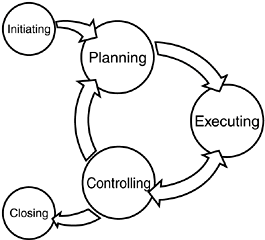Key Project Planning Principles
While most reasonable people will, at least, acknowledge there is value to "planning" at a logical level, many of those same people are less than "emotionally committed" to the practice. Why is this? Generally, it is because the "project planning" they have witnessed has violated one or more of the following key project planning principles.
- Purpose The purpose of project planning is to develop a plan that enables the project to be executed and controlled, as shown in Figure 5.1.
Figure 5.1. Highlights the interactions between the planning, executing, and controlling project management processes.

- Multiple passes required Project planning is not a one-time activity performed at the beginning of a project. For starters, it generally takes several iterations to get to a comprehensive plan given the multitude of inputs that must be integrated and the number of stakeholders that need to agree on the plan. In addition, as things happen and we learn more, plans will need to be adjusted and details ironed out as the project moves along.
caution

A Microsoft Project file (or anything else resembling a project schedule, timeline, or WBS) is not a project plan.
A project plan will generally reference other documents and supplemental plans, including a WBS and project schedule.
tip

A project plan is all-encompassing document that is used as the basis for controlling and executing a project.
- A project plan is NOT a Microsoft Project file Before we go any further, let's make sure we are clear on a few key terms. A project plan is not a project schedule or a Work Breakdown Structure (WBS). A project plan is all-encompassing document that is used as the basis for controlling and executing a project.
- Give me one The planning exercise and the planning team must have control over one of the traditional project success factors (scope, time, cost, or performance). Senior management can set all but one of these factorsjust not all of them.
- "Proactive" project management Effective planning enables a "proactive" project management approach. Before the execution of the project gets underway, we ask the questions and determine the approaches we will take to manage the project and stakeholder expectations regarding project communications, stakeholder responsibilities, quality management, risks, responses to specific performance variances, procurement management, and project team management.
- "Stay down from the mountain" Project planning is not the time for the top-down, Mount Olympus approach to management. Project planning is the time for questions, facilitation, interaction, and feedback.
Specifically, you need to conduct a stakeholder analysis on all of your management and customer stakeholders to validate the project definition elements, understand their expectations and communication needs, and to review procedures for dealing with critical issues, risks, change requests, and performance variances.
In addition, the team members who will be doing the work should be heavily involved in defining and estimating the details of the work to be performed. We address this further in Chapters 6 and 7. This approach leads to a better definition of the work required and a higher commitment level toward scheduled work assignments.
tip
|
Change control, communications, risk, and quality project management are excellent examples of proactive project management. The team approach to project planning greatly increases their acceptance and commitment level to the project plan. |
Part i. Project Management Jumpstart
Project Management Overview
- Project Management Overview
- What Is Project Management…Exactly?
- What Is the Value of Project Management?
- Why Are Projects Challenging?
- Growing Demand for Effective Project Managers?
- Trends in Project Management
The Project Manager
- The Project Manager
- One Title, Many Roles
- Key Skills of Project Managers
- Qualities of Successful Project Managers
- 15 Common Mistakes of Project Managers
Essential Elements for any Successful Project
- Essential Elements for any Successful Project
- What Exactly Is a "Successful" Project?
- Learning from Troubled Projects
- Learning from Successful Projects
- Essential Project Manager Toolkit
Part ii. Project Planning
Defining a Project
- Defining a Project
- Setting the Stage for Success
- How Does Defining a Project Relate to Project Planning?
- Project Definition Document
- Project Definition Checklist
Planning a Project
- Planning a Project
- Key Project Planning Principles
- Important Questions Project Planning Should Answer
- Building a Project Plan
- Summary of Supplemental Project Plan Components
- Project Plan Checklist
Developing the Work Breakdown Structure
- Developing the Work Breakdown Structure
- What Is a WBS Exactly?
- Why Is the WBS Important?
- The Process of Building a WBS
Estimating the Work
- Estimating the Work
- Next Step in the Schedule Development Process
- Managing the Risk, Managing the Estimates
- Reasons for Estimating Woes
- Powerful Estimating Techniques and Methods
- Best Practices
Developing the Project Schedule
- Developing the Project Schedule
- The Impact of the Project Schedule
- The Goal of the Schedule Development Process
- Key Inputs for Building a Schedule
- Creating a Schedule
Determining the Project Budget
- Determining the Project Budget
- The Impact of the Project Budget
- Principles of an Effective Budget
- Creating a Project Budget
- Common Budget Challenges
Part iii. Project Control
Controlling a Project
- Controlling a Project
- What Is Project Control?
- Management Fundamentals for Project Control
- Powerful Techniques for Project Control
- Performance Reporting
- Variance Responses
- Leveraging Earned Value Management Concepts
- Common Project Control Challenges
- Lessons from Project Recoveries
Managing Project Changes
- Managing Project Changes
- What Exactly Is a Project Change and Whats the Big Deal Anyway?
- Fundamentals for Managing Project Change
- What Causes Unplanned Scope Changes?
- Essential Elements of a Project Change Control System
- Powerful Techniques for Minimizing Project Changes
- Common Project Change Control Challenges
Managing Project Deliverables
- Managing Project Deliverables
- "Managing Project Deliverables" Means What Exactly?
- Why Do This? Its Too Much Work
- Identify, Protect, and Track: The Principles of Managing Work Products
- Best Practices
- Configuration Management Plan
- Common Challenges and Pitfalls
Managing Project Issues
- Managing Project Issues
- The Goals, Objectives, and Principles of Project Issue Management
- Key Features of Issue Management System
- Options for Issue Log
- Best Practices
- Some Special Situations
Managing Project Risks
- Managing Project Risks
- Key Risk Management Principles
- The Essential Process for Managing Project Risks
- The Common Sources of Project Risk
- Typical Problems
- Powerful Risk Control Strategies
- Are You Sure Its a Risk?
Managing Project Quality
- Managing Project Quality
- What Is "Project Quality"?
- Unique Aspects of Managing Project Quality
- Principles of Managing Project Quality
- Powerful Tools and Techniques for Project Quality
- Powerful Quality Strategies
- Typical Quality-Related Challenges
Part iv. Project Execution
Leading a Project
- Leading a Project
- More Than Managing
- Where Is Leadership Needed on a Project?
- Twelve Keys to Better Project Leadership
- Power of Servant Leadership Approach
Managing Project Communications
- Managing Project Communications
- What Are Project Communications?
- The Importance of Project Communications
- Why Communicating Can Be Tough
- Seven Powerful Principles
- Best Practices of Effective Project Communicators
Managing Expectations
- Managing Expectations
- Value of Reviewing Stakeholder Expectation Management
- Critical Aspects of Expectations
- Seven Master Principles of Expectation Management
- Essential Elements of Managing Expectations
Keys to Better Project Team Performance
- Keys to Better Project Team Performance
- High-Performing Teams
- Ten Key Principles
- Proven Techniques
- Special Situations
Managing Differences
- Managing Differences
- Five Key Principles
- Proven Techniques for Leading Cross-Functional Projects
- Proven Techniques for Leading Cross-Cultural Projects
- Proven Techniques for Leading Virtual Projects
Managing Vendors
- Managing Vendors
- First, Lets Clarify a Few Terms
- Ten Proven Principles of Vendor Management
- Twelve Tips for Buyers
- Seven Tips for Sellers
- Twelve Key Project Management Skills for Better Vendor Management
- Stuff You Need to Know About Contracts
Ending a Project
EAN: N/A
Pages: 169
